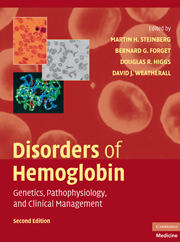Book contents
- Frontmatter
- Contents
- List of Contributors
- Foreword, by H. Franklin Bunn
- Preface
- Introduction, by David J. Weatherall
- SECTION ONE THE MOLECULAR, CELLULAR, AND GENETIC BASIS OF HEMOGLOBIN DISORDERS
- SECTION TWO PATHOPHYSIOLOGY OF HEMOGLOBIN AND ITS DISORDERS
- SECTION THREE α THALASSEMIA
- SECTION FOUR THE β THALASSEMIAS
- SECTION FIVE SICKLE CELL DISEASE
- SECTION SIX OTHER CLINICALLY IMPORTANT DISORDERS OF HEMOGLOBIN
- SECTION SEVEN SPECIAL TOPICS IN HEMOGLOBINOPATHIES
- SECTION EIGHT NEW APPROACHES TO THE TREATMENT OF HEMOGLOBINOPATHIES AND THALASSEMIA
- Index
- Plate section
SECTION EIGHT - NEW APPROACHES TO THE TREATMENT OF HEMOGLOBINOPATHIES AND THALASSEMIA
Published online by Cambridge University Press: 03 May 2010
- Frontmatter
- Contents
- List of Contributors
- Foreword, by H. Franklin Bunn
- Preface
- Introduction, by David J. Weatherall
- SECTION ONE THE MOLECULAR, CELLULAR, AND GENETIC BASIS OF HEMOGLOBIN DISORDERS
- SECTION TWO PATHOPHYSIOLOGY OF HEMOGLOBIN AND ITS DISORDERS
- SECTION THREE α THALASSEMIA
- SECTION FOUR THE β THALASSEMIAS
- SECTION FIVE SICKLE CELL DISEASE
- SECTION SIX OTHER CLINICALLY IMPORTANT DISORDERS OF HEMOGLOBIN
- SECTION SEVEN SPECIAL TOPICS IN HEMOGLOBINOPATHIES
- SECTION EIGHT NEW APPROACHES TO THE TREATMENT OF HEMOGLOBINOPATHIES AND THALASSEMIA
- Index
- Plate section
Summary
The treatment of hemoglobin disorders is evolving and clinical trials of many new agents are underway. Hydroxyurea is used to increase fetal hemoglobin (HbF) levels, stem cell transplantation has the potential for cure, and a larger repertory of iron chelators might make long-term transfusion more feasible. In this section of five chapters, three cover clinically available treatments, discussing in detail aspects of HbF induction, blood transfusion with iron chelation, and stem cell transplantation. One chapter focuses on innovative treatment approaches that remain, at the time of writing, investigative. Treatments include antioxidants, statins, antiinflammatory agents, transport channel inhibitors, antiadhesive agents, and therapeutic methods of increasing nitric oxide bioavailability. The first patients have been treated in a gene therapy trial in which lentiviral vectors containing therapeutic β-like globin genes are used to counter the results of the sickle or β thalassemia mutation, and a final chapter brings this field up to date.
Transfusions are not innocuous and are complicated by alloimmunization, the transmission of unsuspected viral diseases, and iron overload. Controlled, randomized trials of the utility of transfusions for specific complications are sparse. When transfusion is contemplated, expert opinion, with its pitfalls, is relied on in most instances. Usually, it is unclear if simple transfusion or exchange transfusion yields superior results for sickle cell disease complications such as stroke in children or the acute chest syndrome. Strong personal feelings among clinicians regarding the method of transfusion make the chance of definitive clinical trials dim.
- Type
- Chapter
- Information
- Disorders of HemoglobinGenetics, Pathophysiology, and Clinical Management, pp. 687 - 688Publisher: Cambridge University PressPrint publication year: 2009



